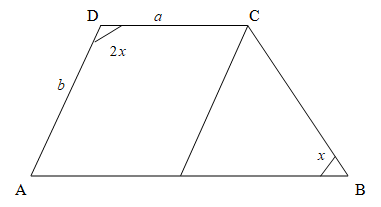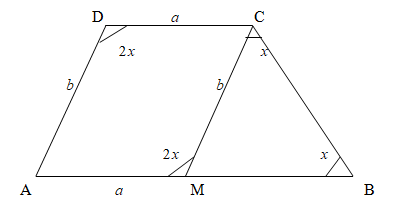
In quadrilateral ABCD,\[AB\parallel CD\]\[\angle D = 2\angle B\], \[AD = b\] and \[CD = a\] then length of side AB is
A.\[a + 4b\]
B.\[a - 3b\]
C.\[a - 2b\]
D.\[a + b\]
Answer
544.5k+ views
Hint: Here we will find the length of the side AB by using all the value given to us. First, we will form a parallelogram using the given dimensions. We will then draw AMCD as a new parallelogram and apply the property of the parallelogram to this. From there, we will get the \[\angle D\] and using it we will find the length of AB in two parts.
Complete step-by-step answer:
We have been given a quadrilateral ABCD where \[AB\parallel CD\] and \[\angle D = 2\angle B\].
Let \[\angle B = x\] so \[\angle D = 2x\].
It is given that \[AD = b\] and \[CD = a\] .
We will draw our quadrilateral using the given dimensions.

As we can see that we have to find the value of AB which is bigger than CD but we also know that CD and AB are parallel. Therefore, we will make a line from point C to line AB which is parallel to AD and name it as M.
Now as \[CM = b\] and \[AM = a\]
As \[AB\parallel CD\], so AMCD is a parallelogram.

By the property of a parallelogram,
\[\angle D = \angle AMC\]
So,\[\angle AMC = 2x\]
Now in \[\Delta MCB\] by the property of a triangle sum of two opposite interior angles is equal to the exterior angle.
So that means,
\[\angle D = \angle MCB + \angle B\]
Substituting \[\angle D = 2x\] and \[\angle B = x\] in the above equation, we get
\[2x = \angle MCB + x\]
$\therefore \angle MCB=x$
Now as we can see that \[\angle MCB = \angle B\] so by triangle property which states that sides opposite to equal angles are equal we get,
\[MB = MC\]
Now as \[AB = AM + MB\]
\[ \Rightarrow AB = a + b\]
Hence, option (D) is correct.
Note: We have used various properties of a triangle and parallelogram in this question some other properties are:
Sum of all the interior angle of a triangle is\[{180^ \circ }\]
A diagonal of a parallelogram divides it into two parts.
Sum of angles of a quadrilateral is \[{360^ \circ }\]
The sum of any two sides of a triangle is greater than the third side.
Complete step-by-step answer:
We have been given a quadrilateral ABCD where \[AB\parallel CD\] and \[\angle D = 2\angle B\].
Let \[\angle B = x\] so \[\angle D = 2x\].
It is given that \[AD = b\] and \[CD = a\] .
We will draw our quadrilateral using the given dimensions.

As we can see that we have to find the value of AB which is bigger than CD but we also know that CD and AB are parallel. Therefore, we will make a line from point C to line AB which is parallel to AD and name it as M.
Now as \[CM = b\] and \[AM = a\]
As \[AB\parallel CD\], so AMCD is a parallelogram.

By the property of a parallelogram,
\[\angle D = \angle AMC\]
So,\[\angle AMC = 2x\]
Now in \[\Delta MCB\] by the property of a triangle sum of two opposite interior angles is equal to the exterior angle.
So that means,
\[\angle D = \angle MCB + \angle B\]
Substituting \[\angle D = 2x\] and \[\angle B = x\] in the above equation, we get
\[2x = \angle MCB + x\]
$\therefore \angle MCB=x$
Now as we can see that \[\angle MCB = \angle B\] so by triangle property which states that sides opposite to equal angles are equal we get,
\[MB = MC\]
Now as \[AB = AM + MB\]
\[ \Rightarrow AB = a + b\]
Hence, option (D) is correct.
Note: We have used various properties of a triangle and parallelogram in this question some other properties are:
Sum of all the interior angle of a triangle is\[{180^ \circ }\]
A diagonal of a parallelogram divides it into two parts.
Sum of angles of a quadrilateral is \[{360^ \circ }\]
The sum of any two sides of a triangle is greater than the third side.
Recently Updated Pages
Master Class 9 Social Science: Engaging Questions & Answers for Success

Master Class 9 Science: Engaging Questions & Answers for Success

Master Class 9 English: Engaging Questions & Answers for Success

Master Class 9 Maths: Engaging Questions & Answers for Success

Master Class 9 General Knowledge: Engaging Questions & Answers for Success

Class 9 Question and Answer - Your Ultimate Solutions Guide

Trending doubts
Which places in India experience sunrise first and class 9 social science CBSE

Fill the blanks with the suitable prepositions 1 The class 9 english CBSE

Write the 6 fundamental rights of India and explain in detail

Difference Between Plant Cell and Animal Cell

What is pollution? How many types of pollution? Define it

What is the Full Form of ISI and RAW





